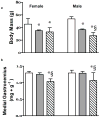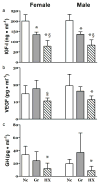Growth inhibition and compensation in response to neonatal hypoxia in rats
- PMID: 23842077
- PMCID: PMC3737398
- DOI: 10.1038/pr.2013.80
Growth inhibition and compensation in response to neonatal hypoxia in rats
Abstract
Background: Hypoxia (Hx) is an important disease mechanism in prematurity, childhood asthma, and obesity. In children, Hx results in chronic inflammation.
Methods: We investigated the effects of Hx (12% O2) during postnatal days 2-20 in rats. Control groups were normoxic control (Nc), and normoxic growth restricted (Gr) (14-pup litters).
Results: The Hx-exposed and Gr rats had similar decreases in growth. Hx increased plasma tumor necrosis factor-α (TNF-α) and interleukin 6 (IL-6) levels and decreased insulin-like growth factor 1 (IGF-I) and vascular endothelial growth factor (VEGF) levels. Hx resulted in hypertrophy of the right ventricle (RV) but disproportionate decrements in limb skeletal muscle (SM) growth. miR-206 was depressed in the hypertrophied RV of Hx rats but was increased in growth-retarded SM. Hx resulted in decreased RV messenger RNA (mRNA) level for myostatin but had no effect on SM myostatin. The mRNA for Hx-sensitive factors such as hypoxia inducible factor-1α (HIF-1α) was depressed in the RV of Hx rats, suggesting negative feedback.
Conclusion: The results indicate that Hx induces a proinflammatory state that depresses growth-regulating mechanisms and that tissues critical for survival, such as the heart, can escape from this general regulatory program to sustain life. This study identifies accessible biomarkers for evaluating the impact of interventions designed to mitigate the long-term deleterious consequences of Hx that all too often occur in babies born prematurely.
Conflict of interest statement
The authors certify that there are no potential perceived conflicts of interest or financial disclosures related to this work.
Figures






Similar articles
-
Hypoxia drives cardiac miRNAs and inflammation in the right and left ventricle.J Mol Med (Berl). 2019 Oct;97(10):1427-1438. doi: 10.1007/s00109-019-01817-6. Epub 2019 Jul 23. J Mol Med (Berl). 2019. PMID: 31338525
-
Heart and lung VEGF mRNA expression in rats with monocrotaline- or hypoxia-induced pulmonary hypertension.Am J Physiol. 1998 Dec;275(6):H1948-56. doi: 10.1152/ajpheart.1998.275.6.H1948. Am J Physiol. 1998. PMID: 9843792
-
Pituitary control of growth in the neonatal rat: effects of neonatal hypophysectomy on somatic and organ growth, serum insulin-like growth factors (IGF)-I and -II levels, and expression of IGF binding proteins.Endocrinology. 1990 Oct;127(4):1792-803. doi: 10.1210/endo-127-4-1792. Endocrinology. 1990. PMID: 1698146
-
The effects of acute and intermittent hypoxia on the expressions of HIF-1α and VEGF in the left and right ventricles of the rabbit heart.Anadolu Kardiyol Derg. 2011 Aug;11(5):379-85. doi: 10.5152/akd.2011.104. Epub 2011 Jun 7. Anadolu Kardiyol Derg. 2011. PMID: 21652295
-
Gestational and early postnatal exposure to simulated high altitude does not modify postnatal body mass growth trajectory in the rat.High Alt Med Biol. 2014 Sep;15(3):418-21. doi: 10.1089/ham.2014.1022. Epub 2014 Sep 3. High Alt Med Biol. 2014. PMID: 25184739 Free PMC article.
Cited by
-
The value of plasma insulin-like growth factor 1 and interleukin-18 in the diagnosis of bronchopulmonary dysplasia in premature infants.Front Pediatr. 2022 Oct 11;10:1013537. doi: 10.3389/fped.2022.1013537. eCollection 2022. Front Pediatr. 2022. PMID: 36304530 Free PMC article.
-
Stratified control of IGF-I expression by hypoxia and stress hormones in osteoblasts.Gene. 2014 Apr 10;539(1):141-51. doi: 10.1016/j.gene.2014.01.011. Epub 2014 Jan 15. Gene. 2014. PMID: 24440782 Free PMC article.
-
A Translational Model of Incomplete Catch-Up Growth: Early-Life Hypoxia and the Effect of Physical Activity.Clin Transl Sci. 2018 Jul;11(4):412-419. doi: 10.1111/cts.12550. Epub 2018 Mar 30. Clin Transl Sci. 2018. PMID: 29603633 Free PMC article.
-
Shiga Toxin-Producing Escherichia coli Infections during Pregnancy.Microorganisms. 2018 Oct 23;6(4):111. doi: 10.3390/microorganisms6040111. Microorganisms. 2018. PMID: 30360505 Free PMC article. Review.
-
Evaluation of altitude-appropriate reference ranges for neutrophils in diagnosis of sepsis in very low birth weight infants: A multicenter retrospective study.PLoS One. 2017 Feb 9;12(2):e0171571. doi: 10.1371/journal.pone.0171571. eCollection 2017. PLoS One. 2017. PMID: 28182674 Free PMC article.
References
-
- Petry CJ, Ozanne SE, Hales CN. Programming of intermediary metabolism. Mol Cell Endocrinol. 2001;185:81–91. - PubMed
-
- Esquer C, Claure N, D’Ugard C, Wada Y, Bancalari E. Role of Abdominal Muscles Activity on Duration and Severity of Hypoxemia Episodes in Mechanically Ventilated Preterm Infants. Neonatology. 2007;92:182–6. - PubMed
-
- Rogers LK, Velten M. Maternal inflammation, growth retardation, and preterm birth: Insights into adult cardiovascular disease. Life Sci. 2011;89:417–21. - PubMed
-
- Eliakim A, Nemet D. Osteopenia of prematurity - the role of exercise in prevention and treatment. Pediatr Endocrinol Rev. 2005;2:675–82. - PubMed
-
- Rohlicek CV, Viau S, Trieu P, Hébert TE. Effects of neonatal hypoxia in the rat on inotropic stimulation of the adult heart. Cardiovasc Res. 2005;65:861–8. - PubMed
Publication types
MeSH terms
Substances
Grants and funding
LinkOut - more resources
Full Text Sources
Other Literature Sources

